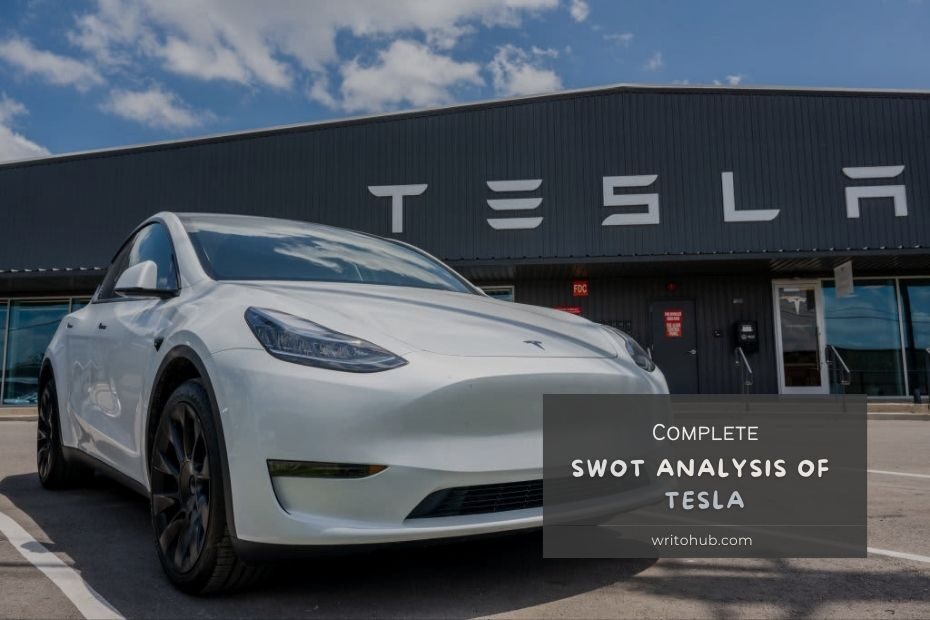The SWOT Analysis of Tesla tells the SWOT (Strengths, Weaknesses, Opportunities, and Threats) of the American multinational automotive and clean energy company – Tesla!
Tesla, an American electric vehicle and clean energy company, has disrupted the automotive industry with its focus on electric cars, energy storage solutions, and renewable energy technologies.
A comprehensive SWOT analysis of Tesla reveals its strengths, weaknesses, opportunities, and threats, offering insights into its strategic position in the dynamic electric vehicle and sustainable energy market.
Strengths in the SWOT Analysis of Tesla
- Innovative Electric Vehicles: Tesla is known for its groundbreaking electric vehicles (EVs) that offer impressive range, performance, and cutting-edge technology.
- Brand Reputation: Tesla has built a strong brand associated with innovation, luxury, and environmental consciousness, attracting a loyal customer base.
- First-Mover Advantage: As an early entrant in the EV market, Tesla has established itself as a leader and trendsetter in electric mobility.
- Battery Technology: Tesla’s advancements in battery technology have contributed to extended range and faster charging times, enhancing the appeal of its vehicles.
- Supercharger Network: Tesla’s proprietary Supercharger network provides fast and convenient charging, addressing a critical concern for EV adoption.
Weaknesses in the SWOT Analysis of Tesla
- Production Challenges: Tesla has faced production bottlenecks and delays in the past, impacting its ability to meet high demand.
- Pricing: While innovative, Tesla’s vehicles are generally positioned at higher price points, limiting accessibility to a broader market.
- Dependence on Government Incentives: Government incentives for EVs can impact Tesla’s sales and profitability, especially if they change or expire.
- Quality Control: Some Tesla vehicles have faced quality control issues, affecting brand perception and customer satisfaction.
- Competition: Traditional automakers and emerging EV manufacturers are entering the market, intensifying competition for market share.
Opportunities in the SWOT Analysis of Tesla
- Global Expansion: Expanding sales and production capabilities in emerging markets can drive Tesla’s growth and market reach.
- Diversification of Models: Introducing more affordable EV models can attract a wider range of customers and broaden Tesla’s customer base.
- Energy Storage Solutions: Tesla’s energy storage products, like Powerwall and Powerpack, can capitalize on the growing demand for clean energy solutions.
- Autonomous Driving Technology: Developing and commercializing fully autonomous driving technology can open new revenue streams.
- Sustainable Energy Ecosystem: Creating a comprehensive ecosystem of EVs, energy storage, and renewable energy solutions can enhance Tesla’s sustainability narrative.
Threats in the SWOT Analysis of Tesla
- Competition: Traditional automakers and tech companies are investing heavily in EV and autonomous driving technology, intensifying competition.
- Regulatory Changes: Evolving regulations and incentives related to EVs and clean energy can impact Tesla’s operations and customer demand.
- Supply Chain Disruptions: Tesla’s reliance on suppliers for components can lead to disruptions in production and delays.
- Battery Supply: Securing a consistent and affordable supply of batteries is crucial for Tesla’s production scale and costs.
- Technological Challenges: Developing and implementing advanced autonomous driving technology presents technical, legal, and safety challenges.
Conclusion
Tesla’s SWOT analysis underscores its role as a pioneering force in electric mobility and sustainable energy solutions, leveraging strengths to address weaknesses, seize opportunities, and mitigate threats.
The company’s ability to continue innovating, expanding its market presence, and maintaining its brand’s allure will determine its continued success in shaping the future of transportation and energy.
Marketing Mix – Click here to read the Marketing Mix of Tesla
